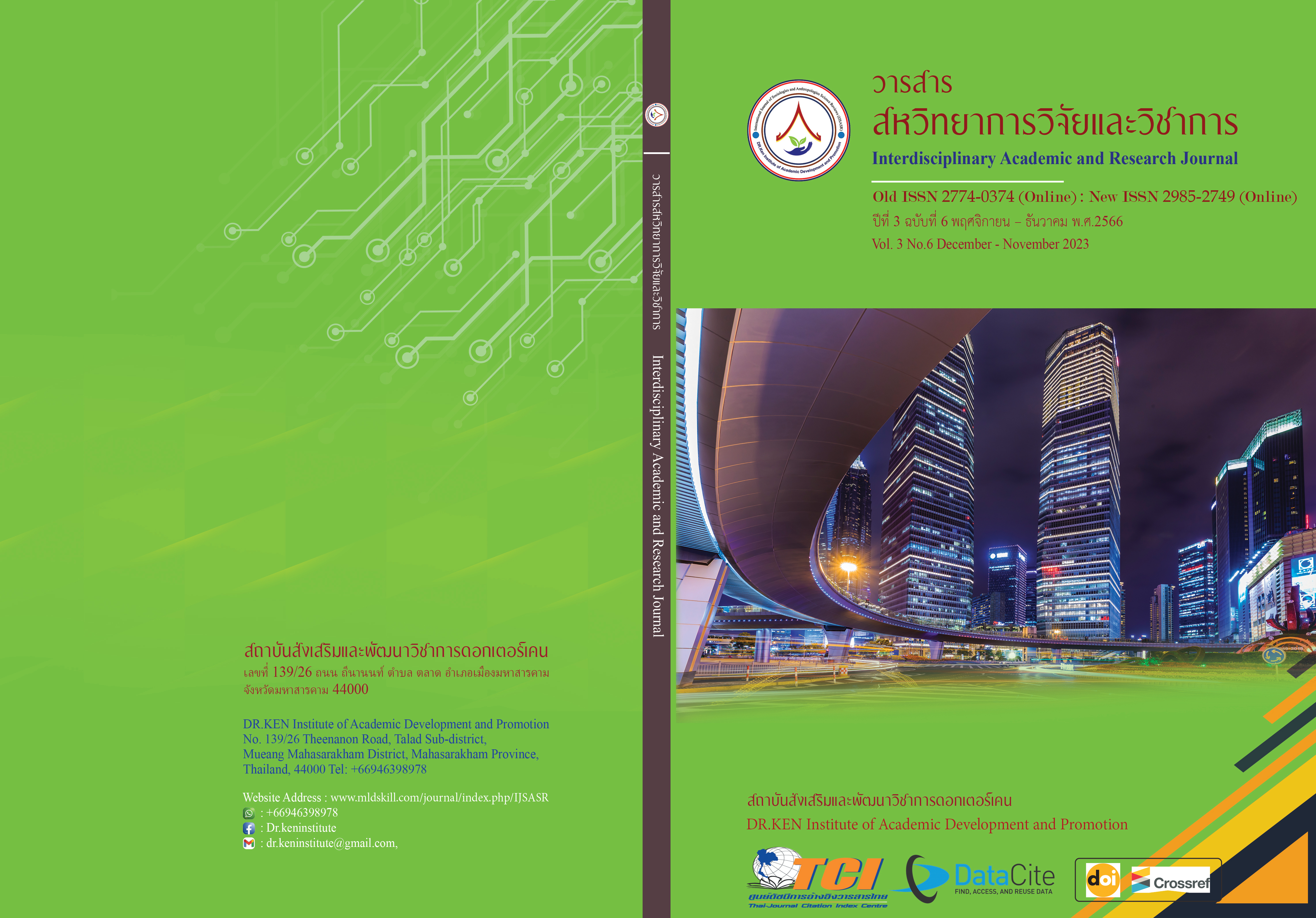A Study to Develop an Operating Model for the Primary Care Service System in Urban Areas of Samut Prakan Province
DOI:
https://doi.org/10.60027/iarj.2023.272477Keywords:
Primary Care System; , Urban Area; , Health Service System; , Model DevelopmentAbstract
Background and Aims: The primary care system is the cornerstone of the health care system. If the primary care system is strong, it will make the health care system efficient. Citizens have more equal access and hospitals can greatly reduce congestion. The objectives of this research were (1) To study the operating situation of the primary service system in urban areas of Samut Prakan Province. (2) To develop a model for primary care operations in urban areas of Samut Prakan Province. And (3) To put the model for developing primary operations in urban areas of Samut Prakan Province into practice.
Methodology: Research and Development conduct both quantitative and qualitative research. Quantitative research: The sample used in the study was people in Bang Kaeo municipality. Samut Prakan Province, 400 people. Tools used: Opinion survey on health service system needs and expectations of desirable health services of people in Bang Kaeo Municipality area Bang Phli, Samut Prakan. Analyze data by frequency and percentage distribution. Qualitative research: The main informant consists of a group of 20 service providers and a group of 20 officers involved in the area. Data was collected through focus group discussions and in-depth interviews. Analyze data using the Content Analysis method.
Results: (1) the situation of primary care system operation in urban areas of Samut Prakan Province. The nature of service delivery is reactive rather than proactive with complex urban space constraints. Registered and passive populations, as well as large obligations and limited staff, pose problems such as inequality in access to health insurance. The linkage of forwarding systems from a reactive-oriented management, and the focus on treatment has resulted in a lack of effort to take care of the patient's problems in the long term. (2) Development of an urban primary operating model in urban areas of Samut Prakan Province. The operating model should provide a comprehensive community health center in the area to provide health services that are the link between the people and the health service system near their homes, it is a service in which the public participates in the management. Planning, Budgeting, co-service, joint monitoring, evaluation and auditing. And (3) the implementation of the model obtained from the collaborative learning process requires the local health system committee to determine the resource allocation policy. Organizing support systems for multidisciplinary personnel teams’ pharmaceutical system, budget system, and financial plan, Patient pick-up and drop-off system, and reactive service arrangement in service units. Therefore, an effective health service system should support the needs of the people. This is in line with the context that contributes to basic care in three main areas: improving the health of the people in charge of responsibility; Meeting people's expectations, there is an acceleration in organizing systems to drive development to be able to respond to the needs of the people by the context and respond effectively to public health problems in urban communities.
Conclusion: The operation of the urban primary service system in Samut Prakan Province is more reactive than proactive due to the complexity of the urban area, the population that is governed by civil registration and the hidden population, and the population that has many responsibilities. Introducing a model for operating in urban areas that includes community health centers can be a good choice, especially in covering public health services and increasing focus on maintaining connectivity of the health service system in the long term. In addition, applying the model obtained from the collaborative learning process to practice with local health system committees can increase the efficiency of the health service system that effectively supports the needs of the people, and is consistent with the context that results in effective basic health care in urban communities.
References
จรวยพร ศรีศลักษณ์และสายสิริ อิสรชาญวานิชย์. (2558). การปฏิรูประบบสุขภาพและการกระจาย อำนาจด้านสุขภาพ. พิมพ์ครั้งที่ 1. นนทบุรี: สถาบันวิจัยระบบสาธารณสุข.
บุญธรรม กิจปรีดาบริสุทธิ์. (2534). สถิติเพื่อการวิจัย. พิมพ์ครั้งที่ 4. กรุงเทพฯ: จามจุรีโปรดักส์.
ภูดิท เตชาติวัฒน์และคณะ. (2560). การสังเคราะห์ทางเลือกของการพัฒนาระบบบริการสุขภาพเขตเมืองเขตสุขภาพที่ 3. นนทบุรี: สถาบันวิจัยระบบสาธารณสุข.
วริศา พานิชเกรียงไกร และคณะ. (2560). การจัดการระบบบริการสุขภาพปฐมภูมิในเขตเมือง กรณีศึกษาจังหวัด นครราชสีมาและจังหวัดบุรีรัมย์. วารสารวิจัยระบบสาธารณสุข. 11 (2), 221-237.
สถาบันวิจัยและพัฒนาระบบสุขภาพชุมชน (สพช.). (2558). บทเรียนการบริการสุขภาพปฐมภูมิในเขตเมือง. กรุงเทพฯ : สถาบันวิจัยและพัฒนาระบบสุขภาพชุมชน.
สำนักงานสาธารณสุขจังหวัดสมุทราปราการ.(2563). สรุปรายงานประจำปี 2563. สมุทรปราการ: สำนักงานสาธารณสุขจังหวัดสมุทราปราการ.
สำนักงานสาธารณสุขจังหวัดสมุทราปราการ.(2564). สรุปรายงานประจำปี 2564. สมุทรปราการ: สำนักงานสาธารณสุขจังหวัดสมุทราปราการ.
สำนักวิจัยเพื่อการพัฒนาหลักประกันสุขภาพไทย(สวปก.). (2552). ระบบบริการปฐมภูมิ (Primary Health Care). Retrieved from: https://kb.hsri.or.th/dspace/handle/11228/473
สุรินทร์ กู้เจริญประสิทธิ์ และพรเทพ ศิริวนารังสรรค์. (2561). การจัดระบบบริการสุขภาพปฐมภูมิในเขตเมือง กรณีศึกษาพื้นที่กรุงเทพมหานคร 2560.วารสารสมาคมเวชศาสตร์ป้องกันแห่งประเทศไทย. 8(2),182-90.
Sritart, S., Tuntiwong, K., Miyazaki, H., & Taertulakarn, S. (2021). Disparities in Healthcare Services and Spatial Assessments of Mobile Health Clinics in the Border Regions of Thailand. Int. J. Environ. Res. Public Health, 18(20), 10782; https://doi.org/10.3390/ijerph182010782.
Macinko, J., Starfield, B., & Shi, L. (2007). Quantifying the Health Benefits of Primary Care Physician Supply in the United States. International Journal of Health Services. 37(1), 111-126. doi:10.2190/3431-G6T7-37M8-P224
Starfield, B. (1998). Primary Care: Concept, Evaluation, and Policy. Oxford University Press.
Strauss, A.L., & Corbin, J. (1990). Basics of Qualitative Research: Techniques and Procedures for Developing Grounded Theory. Sage Publications, Inc.
Downloads
Published
How to Cite
Issue
Section
License
Copyright (c) 2023 Prakit Wongpraset

This work is licensed under a Creative Commons Attribution-NonCommercial-NoDerivatives 4.0 International License.
Copyright on any article in the Interdisciplinary Academic and Research Journal is retained by the author(s) under the under the Creative Commons Attribution-NonCommercial-NoDerivatives 4.0 International License. Permission to use text, content, images, etc. of publication. Any user to read, download, copy, distribute, print, search, or link to the full texts of articles, crawl them for indexing, pass them as data to software, or use them for any other lawful purpose. But do not use it for commercial use or with the intent to benefit any business.
















.png)


